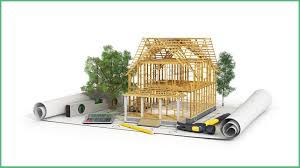Exploring the Benefits of Eco-Friendly Building Materials for Sustainable Construction

The Benefits of Eco-Friendly Building Materials
As the world becomes more environmentally conscious, the demand for eco-friendly building materials is on the rise. These sustainable materials offer a range of benefits that not only help protect the environment but also contribute to healthier living spaces. Let’s explore some of the advantages of using eco-friendly building materials:
Reduced Environmental Impact
Eco-friendly building materials are typically made from renewable resources or recycled materials, reducing the need for new resource extraction. This helps lower carbon emissions and minimizes environmental damage caused by traditional construction materials.
Energy Efficiency
Many eco-friendly building materials are designed to improve energy efficiency in buildings. For example, using insulated concrete forms or energy-efficient windows can help reduce heating and cooling costs, leading to lower energy consumption and decreased utility bills.
Healthier Indoor Environment
Eco-friendly building materials are often free from harmful chemicals and toxins commonly found in traditional construction materials. This results in improved indoor air quality, reducing the risk of respiratory issues and other health problems associated with poor indoor air quality.
Durability and Longevity
Sustainable building materials are known for their durability and longevity, requiring less maintenance and replacement over time. This not only saves money in the long run but also reduces waste generated from constant repairs and replacements.
Aesthetic Appeal
Eco-friendly building materials come in a variety of styles and designs, offering aesthetic appeal while still being sustainable. From bamboo flooring to recycled glass countertops, these materials add a unique touch to any construction project.
Conclusion
Choosing eco-friendly building materials is a smart choice for both the environment and your well-being. By opting for sustainable options, you can create beautiful, energy-efficient spaces that promote a healthier lifestyle while reducing your carbon footprint.
Understanding Eco-Friendly Building Materials: Common Questions and Answers
- What are eco-friendly building materials?
- How do eco-friendly building materials benefit the environment?
- What are some examples of sustainable building materials?
- Are eco-friendly building materials more expensive than traditional materials?
- How can I incorporate eco-friendly building materials into my construction project?
- Do eco-friendly building materials require special maintenance or care?
What are eco-friendly building materials?
Eco-friendly building materials are sustainable construction products that are designed to minimize environmental impact while promoting healthier living spaces. These materials are typically sourced from renewable resources or recycled materials, reducing the need for new resource extraction and lowering carbon emissions. Examples of eco-friendly building materials include bamboo, recycled glass, reclaimed wood, and low-VOC paint. By choosing eco-friendly building materials, individuals can contribute to a greener future by creating energy-efficient, durable structures that prioritize environmental stewardship and sustainability.
How do eco-friendly building materials benefit the environment?
Eco-friendly building materials offer numerous benefits to the environment through their sustainable production and usage. By utilizing renewable resources and recycled materials, these materials help reduce the demand for new resource extraction, thereby lowering carbon emissions and minimizing environmental damage. Additionally, eco-friendly building materials often contribute to improved energy efficiency in buildings, leading to reduced energy consumption and lower greenhouse gas emissions. Overall, the use of eco-friendly building materials plays a crucial role in promoting environmental conservation and creating a more sustainable future for generations to come.
What are some examples of sustainable building materials?
When considering sustainable building materials, there are several examples that stand out for their eco-friendly properties. Bamboo is a popular choice due to its rapid growth and renewability, making it a sustainable alternative to traditional hardwoods. Recycled steel and reclaimed wood are also commonly used materials that help reduce waste and minimize environmental impact. Additionally, materials like recycled glass, cork, and straw bales offer unique options for construction while promoting sustainability and energy efficiency in building projects. By incorporating these examples of sustainable building materials into construction practices, builders can create environmentally friendly structures that contribute to a greener future.
Are eco-friendly building materials more expensive than traditional materials?
When considering eco-friendly building materials versus traditional options, a common question arises: Are eco-friendly building materials more expensive? While it’s true that some eco-friendly materials may have a higher upfront cost than traditional counterparts, it’s essential to look at the bigger picture. Eco-friendly materials often offer long-term savings through improved energy efficiency, reduced maintenance costs, and a positive impact on the environment. Additionally, as demand for sustainable products grows, prices are becoming more competitive, making eco-friendly building materials a viable and cost-effective choice for environmentally conscious construction projects.
How can I incorporate eco-friendly building materials into my construction project?
To incorporate eco-friendly building materials into your construction project, start by researching and selecting sustainable options that align with your project’s goals and budget. Consider using materials such as reclaimed wood, bamboo flooring, recycled glass countertops, energy-efficient windows, and low-VOC paints. Work closely with architects, designers, and contractors who have experience with eco-friendly construction practices to ensure proper installation and integration of these materials. Additionally, prioritize recycling and waste reduction during the construction process to further minimize environmental impact. By making conscious choices and collaborating with professionals knowledgeable in eco-friendly building practices, you can successfully incorporate sustainable materials into your construction project while creating a greener and healthier living space.
Do eco-friendly building materials require special maintenance or care?
When it comes to eco-friendly building materials, one common question that arises is whether they require special maintenance or care. In general, eco-friendly building materials do not necessarily demand more maintenance than traditional materials. However, it is essential to follow manufacturer guidelines and recommendations to ensure the longevity and performance of these sustainable materials. Proper care, such as regular cleaning and upkeep, can help preserve the integrity and sustainability of eco-friendly building materials over time, making them a practical and environmentally conscious choice for construction projects.
